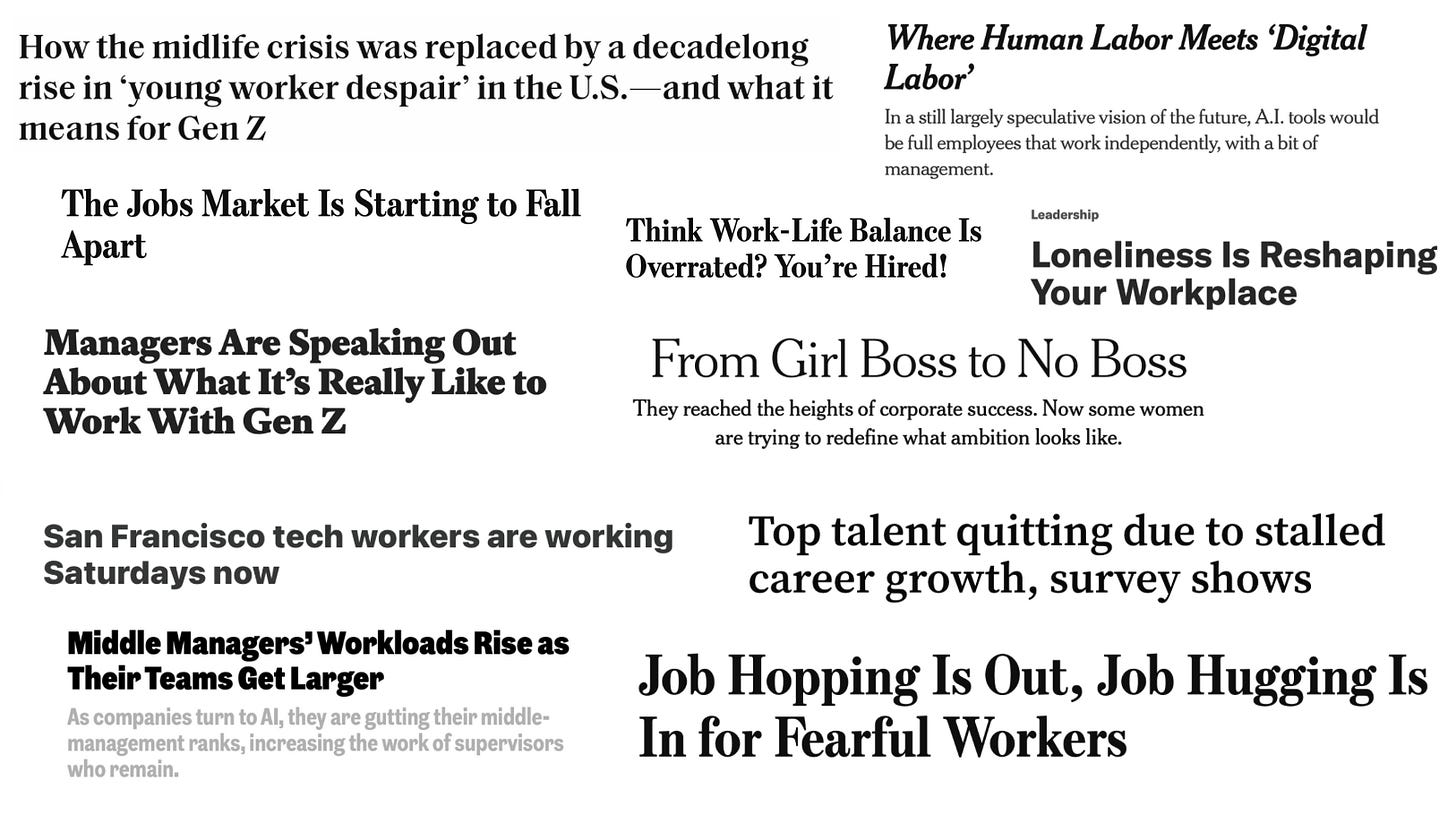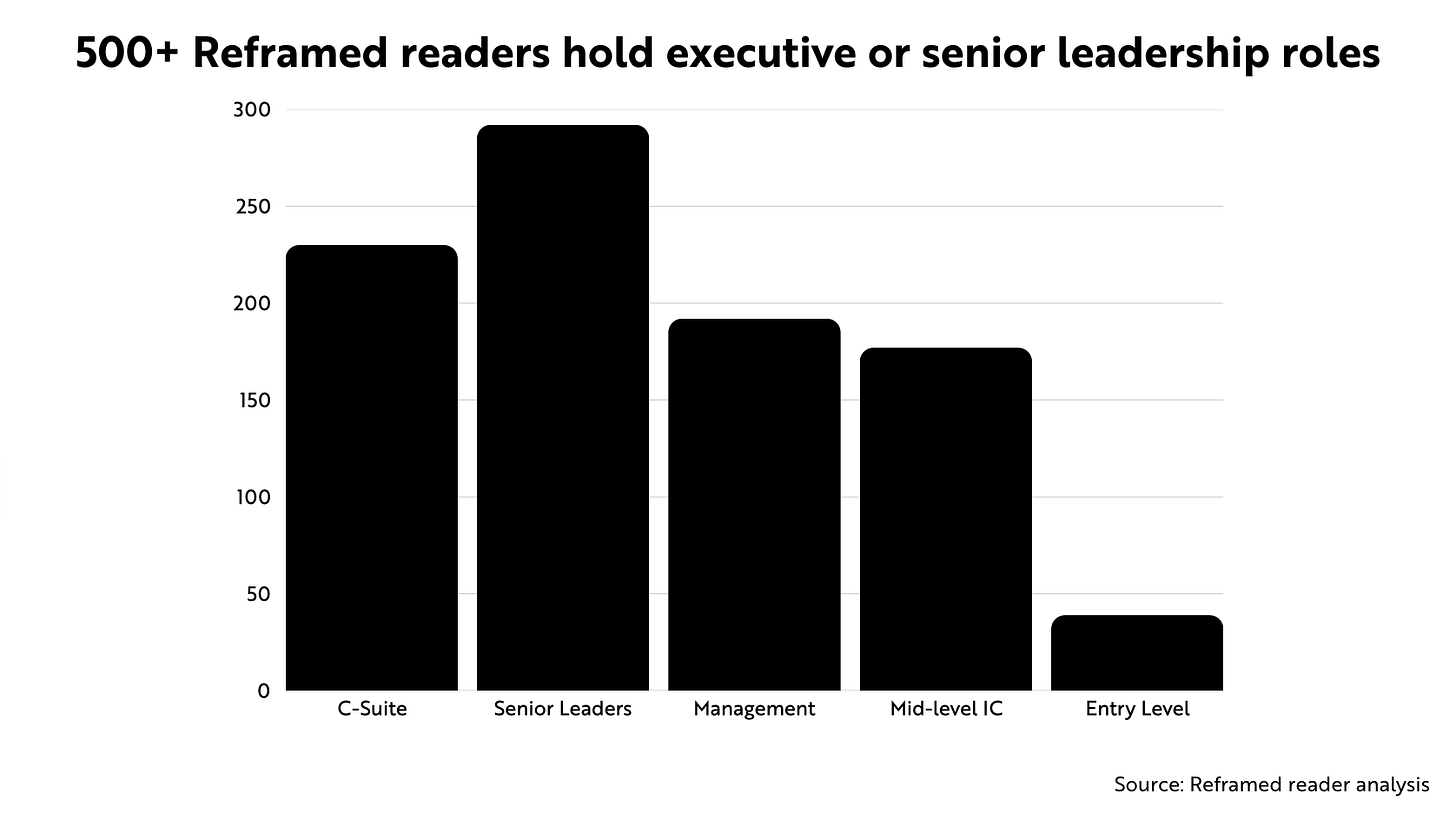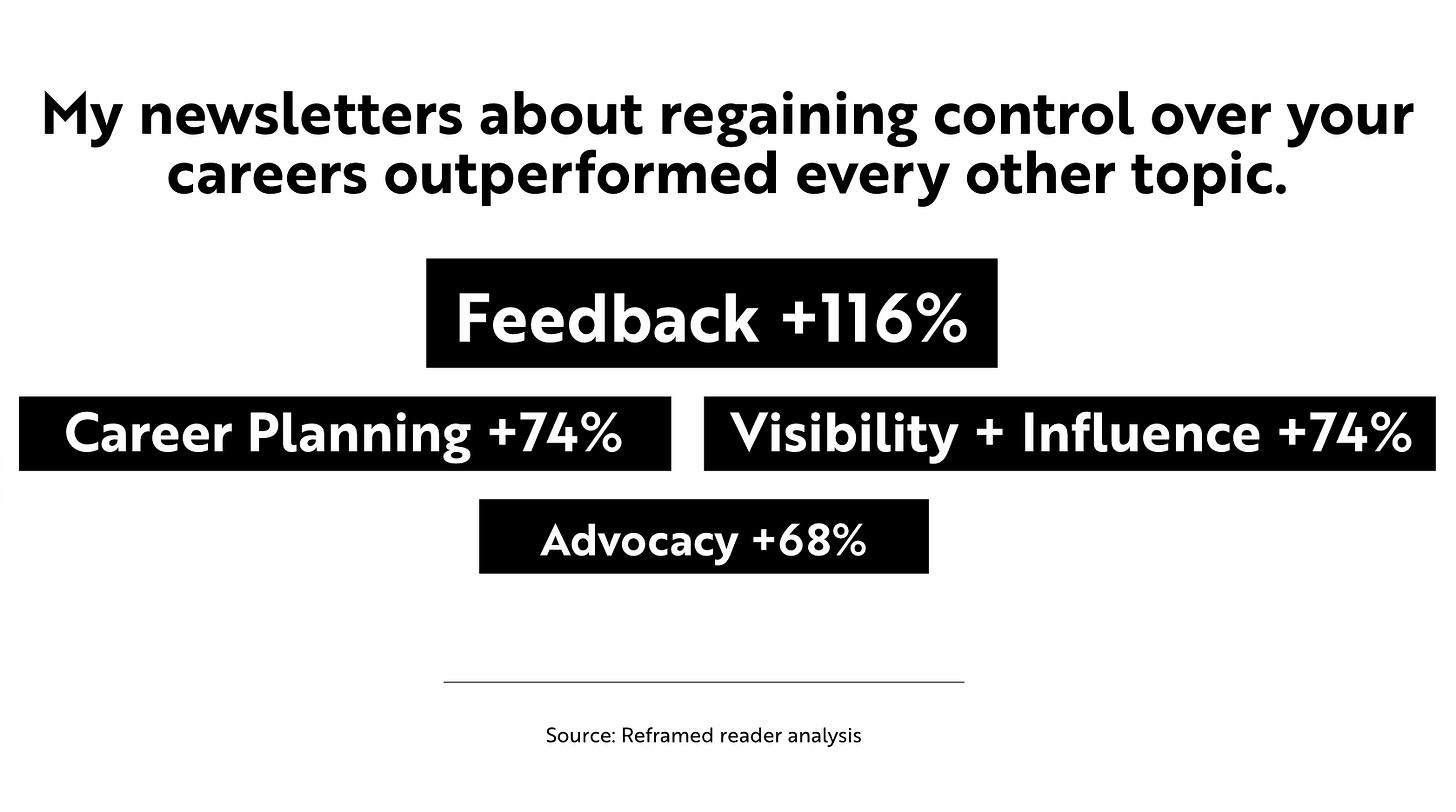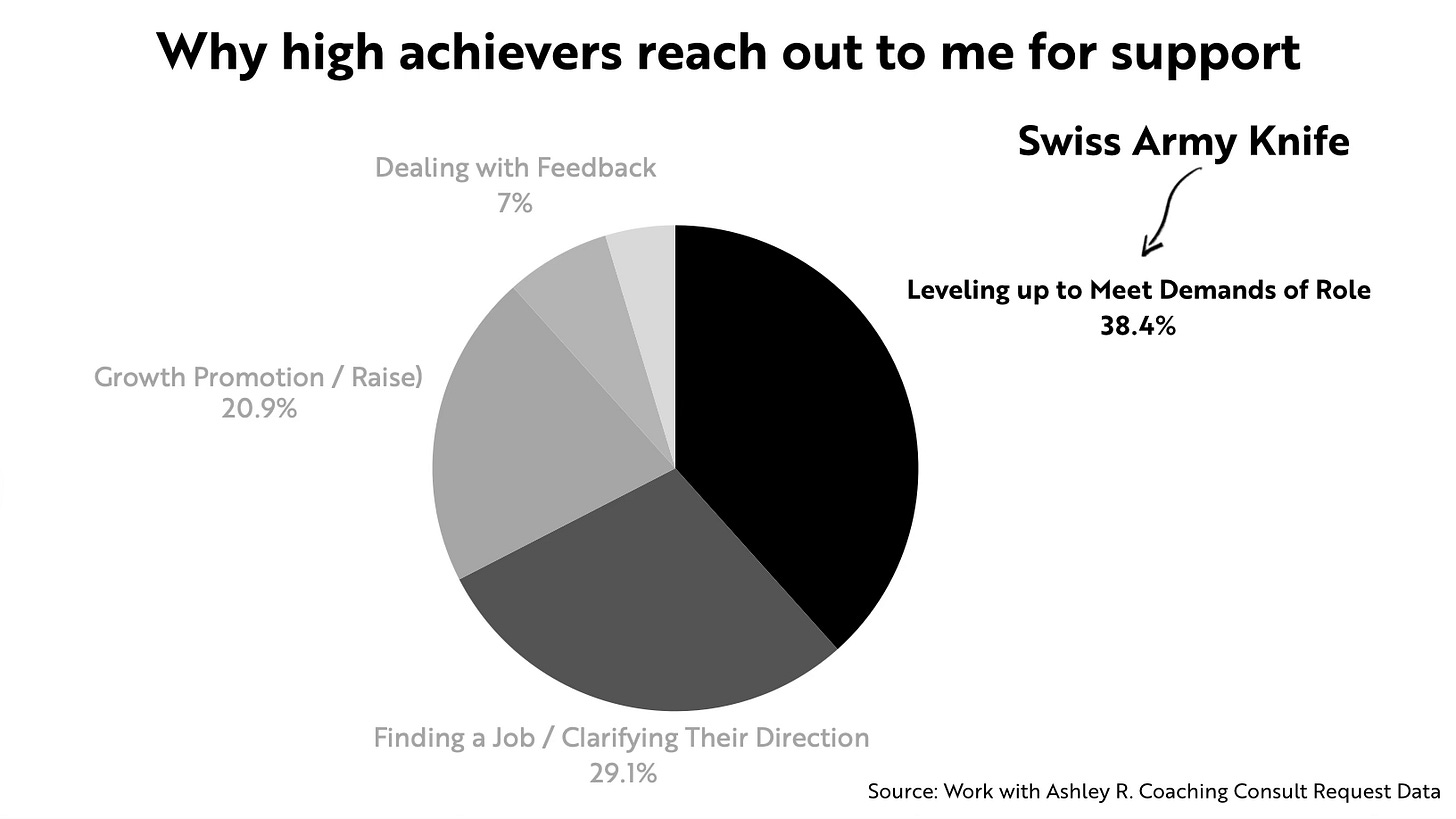CEOs, COOs, and CHROs read Reframed. Here's What I Learned from Them...
Introducing Part 1 of Work Insights Reframed — insights on how ambitious professionals are navigating work in 2025, drawn from thousands of data points, directly from high achievers.
Hi, I’m Ashley. Today’s newsletter is special — a snapshot of the culture of work in 2025, through your eyes. I’m giving you a deep dive look at who Reframed readers are, what work looks and feels like for high achievers, and what trends I’m seeing.
I can’t wait for you to read it.
Today’s workplace is different.
I’ve analyzed thousands of data points; having spent the past two years fully enveloped in the world of work and what it takes to be successful in this environment. The posts you commented on, the DMs you sent, the lead forms you filled out, the stories that spilled out in coaching. They were all clues.
And when I pulled at those threads, a clear picture emerged.
Understanding high achievers is the key to understanding how work will evolve in the coming years. To me, they’re the clearest signal of what the future of work (and success) looks like.
Why High Achievers are the Key to Understanding the Future of Work
High achievers act like early adopters. They find credible voices, adopt new frameworks, and pressure-test ideas in real time. When those experiments work, everyone else pays attention. What starts as niche later becomes the new mainstream playbook (think Radical Candor or James Clear).
I’ve seen it firsthand.
My high-achieving friends were going fractional before it even had a name. They jumped into the startup scene before tech was “hot”. They invested in coaches before everyone else started looking for one. And now, they’re all reading newsletters on Substack ;)
Watch what high achievers do now, and you’ll see what success in the workplace will look like next.
High achievers often become the test case. They end up absorbing risk and ambiguity so others can follow with clarity and confidence. That willingness to step into the unknown is what creates proof points, frameworks, and playbooks for everyone else. BUT it also means they carry the invisible weight of expectation without the safety net of precedent.
Allison Stadd 🥁, CMO at Ollie
A Look at the Data
Today I’m giving you access to insider data—based on thousands of interactions, views, engagement points, and conversations across Substack, LinkedIn, and interactions with my career resources.
Here’s a snapshot of my 2025 data:
Substack: 45 newsletters published, 50k views, 195 unique comments. In short, leaders with incredibly busy schedules are carving out 8-10 minutes every Monday to read Reframed.
LinkedIn: 50 posts, 120k post impressions — one post earned 45k+ impressions. I have a real-time pulse on what ambitious professionals are thinking about every week.
Client insights: My Career Quiz and my coaching client consultation forms — 200+ handpicked responses from high-achieving professionals across tech, creative, and retail/consumer industries.
External signals: I did a deep dive on workplace trends covered in WSJ, Forbes, Fast Company, Inc., HBR, Gallup, and CultureAmp
The Reframed audience is made up of leaders steering today’s most influential companies.
Where do Reframed readers work?
They work in:
Big Tech (Google, Apple, Amazon, Meta, TikTok, LinkedIn)
Entertainment & Media (Condé Nast, A24, NBCUniversal, Universal Music Group, The New York Times, Netflix, YouTube)
Consumer & Beauty (Chanel, Sephora, lululemon, Adidas, Starface, Bobbi Brown)
Consulting & Finance (McKinsey, BCG, Bain, Deloitte, Accenture, JPMorgan, Morgan Stanley, Visa)
And 500+ other organizations.
What are their roles?
I used to casually say that “Reframed is your favorite leader’s favorite newsletter” and you know what? The numbers don’t lie. Founders, Presidents, C-Suite execs, VPs, Principals, Directors, and Partners are all reading.
Where are they located?
Reframed readers are concentrated in global business hubs. The largest clusters are in New York, London, San Francisco, Chicago, Los Angeles, and Toronto—plus strong clusters across Europe, Asia, and emerging markets.
The Career Trends Shaping Work in 2025
Four clear patterns emerged from the data about how top-performing, ambitious professionals are navigating work in 2025. I’ll be covering the first two this week and will follow up next week with the final two.
Trend #1: Career Dissonance
I’ve been talking to high achievers about this feeling; it’s the gap between where they’re at in their careers and where they know they can be. That gap can be internal (something feels off, you lack the confidence and assurance to try something different in your career) or it can be professional (you want to earn more, grow more, or do more but instead, you just feel stuck). Career Dissonance is that feeling.
The Vibe
It makes sense to me that Career Dissonance is trending right now across all employee profiles, especially within the context of an employer-led job market. Employees are feeling less in control; learning and development, perks, and headcount got slashed in cost-savings measures and, according to The Atlantic and countless other sources, the job market is one of the toughest in recent history. For employees, the vibe has shifted to finding ways to reclaim control over their careers (and, by proxy, their lives).
Economic nihilism reflects a growing belief that the structures of work no longer hold inherent meaning or reliable reward. Career dissonance emerges when individuals sense that effort is detached from outcome. The future of work, therefore, is less about climbing prescribed ladders and more about rebuilding systems of value, trust and meaning that can anchor both workers and leaders. Whether that's giving employees more autonomy (why are we forcing people back into offices?!) or redesigning career paths so growth doesn’t require constant title-chasing.
Amy Francombe, Contributing Editor at Vogue Business
For the general employee population, we’ve seen “taking back control” manifest in trends like:
Scam culture, anti work, economic nihilism. I asked Amy Francombe for updated thoughts on economic nihilism and how it relates to career dissonance and she shared the above with me. An incredibly accurate description of the current moment.
Tradwifery (the glamorization of homemaking and the “soft life”) and the rejection of girlboss era habits and ambitions.
And recently on Substack, this newsletter about the death of the corporate job by Alex McCann raked in 7k+ likes, 900 comments, and 1.3k reposts in the span of a week.
The Signals
The data from my Career Quiz illustrates the 4 areas where high achievers are feeling the least in control of their careers right now:
Career planning: 76% don’t have a clear 5-year vision; only 17% say they know their next move.
Becoming “promotable: 50% say leadership respects their work but doesn’t see them as promotable.
Influencing stakeholders: 45% say their ideas earn only polite nods in meetings.
Advocating for themselves: 36% asked for a raise/promotion and got vague excuses; 22% haven’t asked at all.
And in lieu of having this support at work, they’re creating their own “curriculums”filled with credible resources. The most popular topics on Reframed this year were: career planning, improving their visibility and their ability to influence key players, becoming more effective at advocacy, and leveraging tough feedback for growth. The 18 newsletters I wrote centered on these topics pulled in 55% of my content views, including this one — my most popular to date.
The Risks
Conventional wisdom assumes that this kind of dissonance is related to capability, but that’s actually not the case at all in today’s workplace. It’s the frustration of wanting more in an environment where the ladder itself is disappearing. If left unaddressed, dissonance can chip away at motivation and create periods where employees feel stuck. This feeling leads to lower levels of productivity, higher turnover, and increased levels of discontentment. Ultimately, this phenomenon is bad for business, specifically for companies that seek to retain top talent.
In 2024, 373 public company chief executives left their positions.
Wall Street Journal
Trend #2: Swiss Army Knife Leadership
High achievers have always been the Swiss Army knives of the workplace. Their adaptability and problem-solving made them the go-to for the toughest challenges. But now? That expectation is becoming the norm for everyone. Specialization is out. Today’s workplace demands leaders who flex across functions, switch hats constantly, and carry a wider load than ever before — often without the resources to match. We’re in the Swiss Army Knife era.
The Vibe
Leaders are pushing through significant change at work: layoffs, leaner teams, corporate politics, and rising tensions from the shift to hybrid work or RTO mandates. Modern leaders are expected to be at least five different types of leaders rolled into one:
Reporting and metrics wizard
People manager, coach, and task executor
Financial forecaster and planner
Macro-trend interpreter
Crisis manager
And they’re often asked to switch hats in the same day, sometimes in the same meeting. Some leaders are feeling the tension. Even the most capable find it challenging to be great at all of these things at once. Yet the current system is structured as if they should be.
The Signals
Gallup’s 2025 data shows managers are disengaging faster than any other group, especially younger and female leaders, under “do more with less” mandates. Only 27% of managers reported being engaged.
There’s a solution here. In the same report, Gallup notes that manager thriving increases by 32% with training and even more when someone actively encourages development, manager thriving increases to 50%.
Similarly in CultureAmp’s recent Pulse of the Workplace Report one of the biggest drivers of employee engagement is confidence in leadership. But if you pair that with my previous observation where leaders are squeezed — stretched to the max in the context of our current environment — their teams are likely picking up on it. There’s a trickle down effect.
CEO exits spiked 24% year-over-year, signaling instability at the top and pressure cascading down. High achieving deputies are also leaving. They’re doing the math and saying “no” to promotions that look like 10% more pay for 30% more work.
In my own work, I see this trend play out every day. Almost 40% of my incoming coaching client leads mention being recently promoted or tapped to lead new teams. They reach out because they want a co-pilot and a clear path to success as they step into bigger roles. They know the stakes are higher. Unlike the Gallup data, these leaders haven’t reached the point of disengagement; they see coaching as a way to accelerate their success.
“I started a new role with a bigger scope than anticipated without the typical structures I've had when reporting into the CHRO. I'm now the most senior HR person in the org, reporting to the COO. I’m feeling overwhelmed already, I’m only a month in.”
Lead Form Respondent (Tech)
The Risks
Being in leadership and even middle management has never been easy, but now the expectations-to-reality gap is wider than ever. Leaders are asked to excel at multiple expertise areas at once, now with fewer resources than before. And the ultimate risk is exhaustion, burnout, and turnover at the very level companies depend on to steady the ship.
When capable managers become disengaged, their teams feel it first. Morale dips, performance lags, and promising employees start looking elsewhere (some of my clients are constantly evaluating external offers). Over time, this creates a hollowing out effect: the people best positioned to rise into senior roles are too depleted to step forward.
This confirms a lot of what people have been feeling. The state of work can be summed up in one word: challenging.
I’ll leave you with this.
I was chatting with the leadership team at one of my long term clients about navigating challenges — particularly right now, when so much of our lives (at work, personally, and in the world) feels uncertain. They were feeling stuck between being real and transparent with teams about the challenges the business was facing but wanting to keep their teams focused and motivated and not panicked. They couldn’t find the right balance. So I asked them “what did you do the last time things were really hard”? That opened up a conversation about what it was like to hunker down during the financial crash in ‘08, during COVID lockdowns in 2020, and a few other times when their industry experienced seismic shifts. Sometimes they were forced to make hard decisions (layoffs/furloughs), other times they leaned in, got creative, and had record breaking years for the business. Their conclusion? We have what it takes to make it through this, we’ll figure out how. Sustainably. With care. We might need to make some tough decisions. But, we’ll figure it out.
If you’re reading this and feel like you’re also navigating choppy and uncertain waters right now, just know you’re capable of leading through them too.
Next week I’ll share part 2: the two final trends in this inaugural report.
Check back in next Monday at 8am. See you next week.
Ashley
SHARE WORK INSIGHTS REFRAMED →
You’ve probably already forwarded this to your favorite group chat, but if you haven’t...click the button below.
Thank you Amy Francombe, Melanie Ehrenkranz, Allison Stadd 🥁, Swabreen Bakr, and others for your feedback and thoughts!







Whew! Between the layoffs, me being one them, the other facts don’t surprise me even in the slightest. Work is a weird thing these days.
I’m sure I speak on behalf of most (all?) sustainability and impact leaders when I say - welcome to the Swiss Army knife era, it’s nice to have you here 🫠
(Also so interesting to see such a high % of people struggling with influence - why do you think? Lack of skills development? Or similar shifts in audience?)